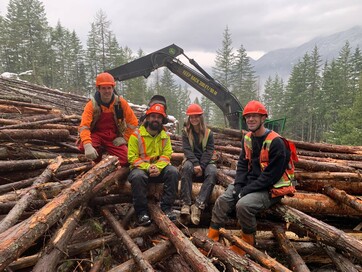
For Immediate Release
December 8, 2021
SICAMOUS, B.C.: A wildfire risk reduction project, valued at almost $1 million, has been steadily making progress to provide greater protection from wildfires around the perimeter of Sicamous, and is close to wrapping up. The Forest Enhancement Society of BC (FESBC) has funded the project which is helping to protect high risk areas as outlined in the District of Sicamous’ (DOS) Community Wildfire Protection Plan (CWPP). The work is providing greater comfort to not only forestry professionals and District staff who recognize the need for proactive action to reduce wildfire risk, but for citizens of Sicamous as well.
“The 2021 wildfires throughout the province and in our area were an eye opener for many in the community,” said Steve Giesbrecht, RPF, Natural Resources Manager at Landmark Solutions, one of the companies involved in the project. “We had started work back in the fall of 2020 by thinning trees and cleaning up ladder fuels and thought this summer’s Two Mile Road fire may enter our treatment areas. In the end it didn’t but confirmed the importance of the work we’re doing to reduce the risk of a catastrophic wildfire because we know that if we can keep fires lower to the ground and out of the tops or the crown, we give firefighters a better chance to control a wildfire.”
The work will better protect important infrastructure like a water reservoir owned by the DOS, as well as vital transportation corridors.
“The fuel management work we’re doing with the FESBC funding is very selective,” said Giesbrecht. “The prescription focuses on reducing ground fuels and understory trees, plus pruning and selective thinning of mature conifers resulting in a more open forest with a park-like aesthetic.”
The first area where work started was on the community’s eastern boundary, an area with dense second growth Douglas Fir, Larch, Cedar, and Hemlock stands that extend from mountain tops to valley bottoms. These forests include high risk wildfire threats because of the density of the trees and the steep slopes in the area. It has meant Nadine Overwater, owner of Nakimu Venture Inc., and her crews have had to do a lot of the work by hand and with smaller, more maneuverable machines.
“Our crews have been on the ground thinning the understory by pruning and brushing to remove ladder and ground fuels, and it’s been hard work due to the steep terrain,” said Overwater. “The locals in the area have shared how ecstatic they are with the work we’ve been doing to create nicer, safer forests, and in the event of a fire, better conditions for workers to put fires out faster. The spin off benefits for outdoor enthusiasts to enjoy the forests is huge and will be great for Sicamous to invite tourists to get out and explore. We’re very happy to be a part of this work and will be wrapping up what we can in the next few weeks before the snow is too deep to work, and plan to do some final work next spring.”
Another benefit for the DOS is the opportunity to utilize the forest fibre Overwater and her crew are generating from their work. Some debris, or biomass, is being chipped and hauled to River City Fibre in Kamloops to be utilized for bioenergy conversion which will significantly reduce the amount of carbon being released into the atmosphere compared to burning debris piles, thus reducing greenhouse gas emissions.
“From the start, the District’s Fire Chief Brett Ogino has been keen on the idea of ‘waste not, want not’ when it came to the work,” said Giesbrecht. “Maximizing the utilization of the wood fibre is an innovative way to be good stewards of the land.”
Closely collaborating on this project is Dave Conly, RPF, Operations Manager with FESBC.
“There were many lessons those in the forestry sector learned not just this year but for some time now,” said Conly. “We know that with good planning and taking action to do the proper fuel management treatments, wildfire hazards can be reduced. From the beginning, our team has been impressed with how coordinated and collaborative the project has been with many groups and agencies to ultimately reduce wildfire risk in critical areas.”
The funding FESBC provided has enabled the DOS to seek out partnerships with First Nations, explore opportunities on how to keep locals and tourists safe, and protect infrastructure. The project also compliments areas adjacent to the treatment which are managed by B.C. Timber Sales, providing an even bigger wildfire risk reduction area.
Giesbrecht said, “without this funding, we would not be in as good of a position as we are today. We thank FESBC and the provincial government for their financial support of this project to make it a reality.”
For more information or an interview with the Forest Enhancement Society of BC and other partners:
Aleece Laird, Communications Liaison, FESBC | communications@fesbc.ca | 250.574.0221
-30-
View the PDF version.
